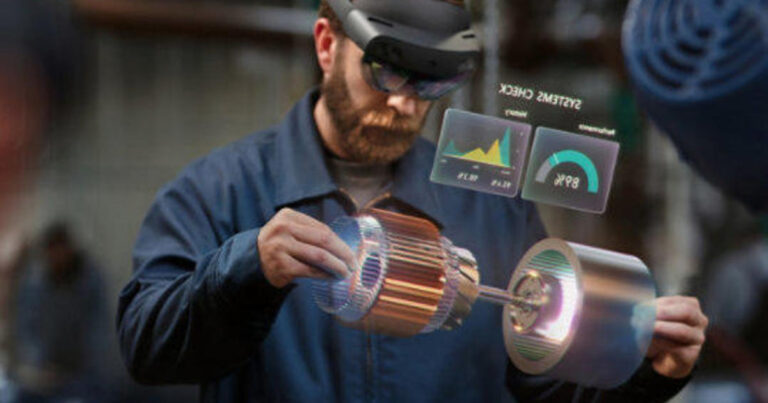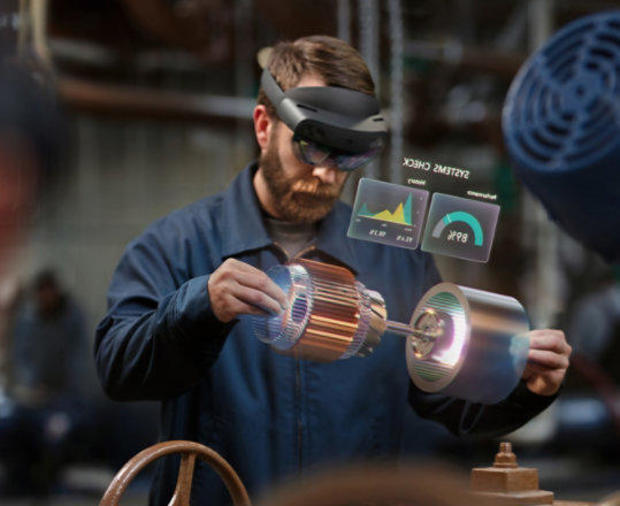
Source: www.cbsnews.com
It can be hard to fathom the “metaverse,” the expanding galaxy of online experiences that companies like Apple, Meta (formerly known as Facebook) and Microsoft see it as the next stage of the Internet. Fortunately, the curious don’t just have to imagine this emerging digital domain—they can start exploring it today.
Your ticket: one of the interconnected virtual and augmented reality devices now on the market that allow you to take advantage of a growing class of immersive gaming, workplace collaboration tools, non-fungible tokens and other applications that seek to merge the physical and digital worlds.
“The metaverse isn’t just a virtual reality that we opt into over real life,” said Michael Pachter, a technology and gaming analyst at investment firm Wedbush. “It will be a diverse experience for everyone, much like today’s internet. When you work, you can sit at a traditional desktop computer, and when you travel you use a phone. One doesn’t replace the other. Instead, different devices enhance and extend your experience.” The metaverse will be similar.”
It’s important to note that, in its current form, the metaverse exists as a primordial soup of old and new technologies, as well as some advancements that are still on the drawing board. It will require updated cloud infrastructure, novel operating systems, and fully immersive applications. This software layer will rest on top of the virtual and augmented reality hardware.
“Gaming is the ‘killer app’ of the metaverse,” Pachter said. “It’s something everyone can understand right away. So are work apps. These products will drive early adoption.”
While the market may take a decade or more to mature, major tech companies are already pouring billions into metaverse products. The gateway for most of us will be VR and AR glasses. For example, Apple is likely to enter the market for augmented reality headsets soon, according to media reports, with a more expensive device aimed at early adopters. The iPhone maker’s biggest rivals and dozens of startups have had a head start on designing mixed-reality products for businesses and consumers.
The following are some of the coolest metaverse products you can buy and use right now.
Augmented reality
HoloLens 2 – $3,500
Microsoft
Microsoft Hololens are expensive and not designed for consumers yet. The mixed reality headset is aimed at manufacturing, healthcare and other industries, but it originated as a headset for Microsoft’s Xbox gaming console, dubbed the Baraboo. The Baraboo’s screen was fuzzy and the device heavy. It wasn’t clear that Microsoft knew how to market the headset, which was eventually scrapped before being re-envisioned as a business tool.
The Hololens 2 is lightweight and image quality is sharp. Unlike other VR products that completely block users’ vision, Hololens makes it easy to shift focus from the real world to the virtual images on the screen. Its software is designed to help business collaboration, and the headset is clearly priced for corporate customers. That said, it’s easy to imagine Microsoft, which also owns the Xbox brand and several game development studios, producing similar gaming headsets.
Perhaps more than any other device, Hololens 2 heralds a wide range of potential uses for mixed reality.
Lenovo ThinkReality A3 – $1,499
Lenovo’s augmented reality glasses mimic a large virtual workstation and connect with Windows laptops to enable remote collaboration features. The device comes with interchangeable lenses and frames, allowing you to customize it for comfort.
magic jump 1 – $2,295
The first product from AR pioneer Magic Leap is underpowered and requires a somewhat clunky external processing unit. The experience, however, can be impressive. It is also the first professional AR device to offer prescription lens compatibility. In short, Magic Leap’s first product may be flawed, but it explains why creative professionals are excited about AR.
Bonus: your smartphone
You can experiment with creating and viewing augmented reality right now, whether you’re running an iPhone running iOS11 or newer, or a modern Android device. Both mobile device manufacturers offer software development kits that allow independent developers and large companies to create AR applications. Get started now with apps for iOS and Android.
Virtual reality
goal mission 2 – $399
Goal
It’s easy to understand why Meta is all the rage in the metaverse. The social media company exists on today’s smartphones as a suite of apps (Facebook, Messenger, WhatsApp and Instagram) that effectively bind it to the rules of companies like Apple and Google. For example, recent iOS updates limited the information Meta could collect from iPhone users.
As a result, Meta wants to create both the hardware (the Oculus VR headset, for example) and the software needed to navigate the metaverse. That would help avoid a similar dilemma, where the company becomes dependent on its VR competitors.
Meta’s Oculus Quest 2 is one of the most accessible and affordable VR headsets available today. Unlike many of its rivals, the wireless device doesn’t require a rugged PC. It runs apps and games natively and is easy to use.
The downside is that apps are limited and the device has low resolution compared to its more expensive rivals. The headset also requires a Facebook login, although the company says this will change soon.
With the successor to Quest 2 expected in 2022, Meta has an opportunity to attract many first-time VR consumers and retain its current users by offering a compelling new product. If it’s anything like Oculus’ current set of VR headsets, Meta’s next headset could be a big hit.
Valve Index – $999
Video game publisher Valve owns Steam, one of the world’s largest online video game marketplaces. So it makes sense that Valve would also make the Index VR Kit. This expensive system ships with a huge viewer, location sensors, controller wands, and power supply, and requires a powerful external PC. If you can get past those hurdles, Index offers a VR gaming experience like no other.
Live Flow – $499
HTC’s Vive Flow is a relatively affordable, accessible and portable virtual reality system. The glasses’ built-in software focuses on mental and physical health. The device also comes with a smartphone app to help track and manage the time you spend in VR.
Bonus: Google Cardboard – $15
https://arvr.google.com/cardboard/
Google Cardboard is an affordable and easy way to experience virtual reality. The company sells cardboard kits that use your smartphone as a screen. Cardboard apps are easy to download and are generally focused on education and entertainment.
In short, the metaverse now looks like the Internet in the 1990s, Wedbush’s Pachter said. “It’s great to be an early adopter, but all we know is that we don’t know the real winners of ‘Web 3’ things like the metaverse. Meta’s Oculus has a huge first mover advantage, and Apple knows how to make products that people like. But in 1996, the winners looked like Microsoft’s AOL Messenger and Internet Explorer.”
Read More at www.cbsnews.com



